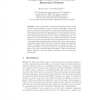Free Online Productivity Tools
i2Speak
i2Symbol
i2OCR
iTex2Img
iWeb2Print
iWeb2Shot
i2Type
iPdf2Split
iPdf2Merge
i2Bopomofo
i2Arabic
i2Style
i2Image
i2PDF
iLatex2Rtf
Sci2ools
MLMI
2007
Springer
2007
Springer
Integrating Semantics into Multimodal Interaction Patterns
A user experiment on multimodal interaction (speech, hand position and hand shapes) to study two major relationships: between the level of cognitive load experienced by users and the resulting multimodal interaction patterns; and how the semantics of the information being conveyed affected those patterns. We found that as cognitive load increases, users’ multimodal productions tend to become semantically more complementary and less redundant across modalities. This validates cognitive load theory as a theoretical background for understanding the occurrence of particular kinds of multimodal productions. Moreover, results indicate a significant relationship between the temporal multimodal integration pattern (7 patterns in this experiment) and the semantics of the command being issued by the user (4 types of commands), shedding new light on previous research findings that assign a unique temporal integration pattern to any given subject regardless of the communication taking place.
| Added | 08 Jun 2010 |
| Updated | 08 Jun 2010 |
| Type | Conference |
| Year | 2007 |
| Where | MLMI |
| Authors | Ronnie Taib, Natalie Ruiz |
Comments (0)

